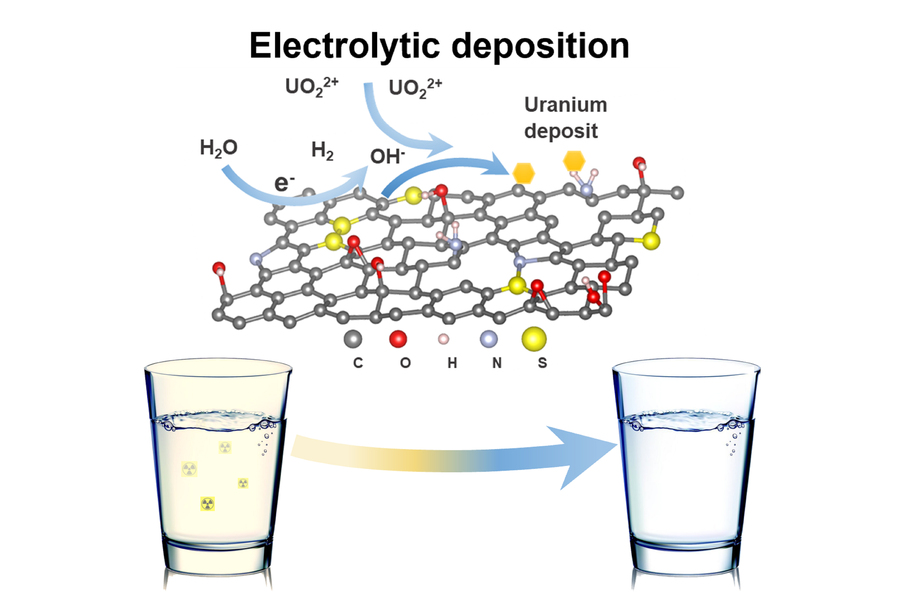Using graphene foam to filter toxins from drinking water
Published on by Water Network Research, Official research team of The Water Network in Academic
MIT-led research team fashions graphene foam into device that can extract uranium and other heavy metals from tap water.
Leda Zimmerman | Department of Nuclear Science and Engineering

A reusable 3D functionalized reduced graphene oxide foam (3D‐FrGOF) is used as an in situ electrolytic deposition electrode to extract uranium from contaminated water.
Credits: Image courtesy of the researchers.
Some kinds of water pollution, such as algal blooms and plastics that foul rivers, lakes, and marine environments, lie in plain sight. But other contaminants are not so readily apparent, which makes their impact potentially more dangerous. Among these invisible substances is uranium. Leaching into water resources from mining operations, nuclear waste sites, or from natural subterranean deposits, the element can now be found flowing out of taps worldwide.
In the United States alone, “many areas are affected by uranium contamination, including the High Plains and Central Valley aquifers, which supply drinking water to 6 million people,” says Ahmed Sami Helal, a postdoc in the Department of Nuclear Science and Engineering. This contamination poses a near and present danger. “Even small concentrations are bad for human health,” says Ju Li, the Battelle Energy Alliance Professor of Nuclear Science and Engineering and professor of materials science and engineering.
Now, a team led by Li has devised a highly efficient method for removing uranium from drinking water. Applying an electric charge to graphene oxide foam, the researchers can capture uranium in solution, which precipitates out as a condensed solid crystal. The foam may be reused up to seven times without losing its electrochemical properties. “Within hours, our process can purify a large quantity of drinking water below the EPA limit for uranium,” says Li.
A paper describing this work was published in this week Advanced Materials. The two first co-authors are Helal and Chao Wang, a postdoc at MIT during the study, who is now with the School of Materials Science and Engineering at Tongji University, Shanghai. Researchers from Argonne National Laboratory, Taiwan’s National Chiao Tung University, and the University of Tokyo also participated in the research. The Defense Threat Reduction Agency (U.S. Department of Defense) funded later stages of this work.
Targeting the contaminant
The project, launched three years ago, began as an effort to find better approaches to environmental cleanup of heavy metals from mining sites. To date, remediation methods for such metals as chromium, cadmium, arsenic, lead, mercury, radium, and uranium have proven limited and expensive. “These techniques are highly sensitive to organics in water, and are poor at separating out the heavy metal contaminants,” explains Helal. “So they involve long operation times, high capital costs, and at the end of extraction, generate more toxic sludge.”
To the team, uranium seemed a particularly attractive target. Field testing from the U.S. Geological Service and the Environmental Protection Agency (EPA) has revealed unhealthy levels of uranium moving into reservoirs and aquifers from natural rock sources in the northeastern United States, from ponds and pits storing old nuclear weapons and fuel in places like Hanford, Washington, and from mining activities located in many western states. This kind of contamination is prevalent in many other nations as well. An alarming number of these sites show uranium concentrations close to or above the EPA’s recommended ceiling of 30 parts per billion (ppb) — a level linked to kidney damage, cancer risk, and neurobehavioral changes in humans.
The critical challenge lay in finding a practical remediation process exclusively sensitive to uranium, capable of extracting it from solution without producing toxic residues. And while earlier research showed that electrically charged carbon fiber could filter uranium from water, the results were partial and imprecise.
Wang managed to crack these problems — based on her investigation of the behavior of graphene foam used for lithium-sulfur batteries. “The physical performance of this foam was unique because of its ability to attract certain chemical species to its surface,” she says. “I thought the ligands in graphene foam would work well with uranium.”
Simple, efficient, and clean
Taxonomy
- Heavy Metal Removal
- Heavy metals